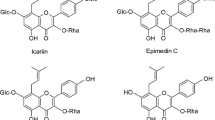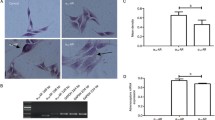Abstract
We investigated the influence of simvastatin, a statin, on the secretion of catecholamines (CA) in rat adrenal glands, and clarified its action mechanism. Simvastatin suppressed acetylcholine (ACh)-evoked CA release in a dose- and time-dependent fashion. In the presence of simvastatin, CA secretion evoked by 1.1-dimethyl-4-phenyl piperazinium iodide (DMPP), angiotensin II, high K+, veratridine, and Bay-K-8644 was time-dependently inhibited. However, in the simultaneous presence of simvastatin and Nω-nitro-l-arginine methyl ester hydrochloride, CA secretion evoked by angiotensin II and DMPP recovered to control levels. Adrenal NO release was increased by simvastatin-treatment. Simvastatin-inhibited CA secretion was not affected by treatment with mevalonate. Pravastatin did not influence ACh-evoked CA secretion, while atorvastatin reduced it. In the simultaneous presence of simvastatin and fimasartan, ACh-induced CA release was markedly reduced compared to that of fimasartan-treatment alone. We present the first evidence that simvastatin reduces adrenal CA secretion induced by stimulation of nicotinic and AT1-receptors. Simvastatin-induced inhibition seems to involve reducing the influx of both Ca2+ and Na+ into adrenochromaffin cells, partly via the elevation of NO production by NO synthase activation, without inhibition of 3-hydroxy-methylglutaryl coenzyme A reductase. Co-administration of simvastatin and fimasartan may be clinically helpful for the treatment of cardiovascular diseases.









Similar content being viewed by others
References
Anton AH, Sayre DF (1962) A study of the factors affecting the aluminum oxide trihydroxy indole procedure for the analysis of catecholamines. J Pharmacol Exp Ther 138:360–375
Azizi M, Guyene TT, Chatellier G, Wargon M, Ménard J (1997) Additive effects of losartan and enalapril on blood pressure and plasma active renin. Hypertension 29:634–640
Bergdahl A, Persson E, Hellstrand P, Swärd K (2003) Lovastatin induces relaxation and inhibits L-type Ca2+ current in the rat basilar artery. Pharmacol Toxicol 93:128–134
Blanco-Rivero J, de las Heras N, Martín-Fernández B, Cachofeiro V, Lahera V, Balfagón G (2011) Rosuvastatin restored adrenergic and nitrergic function in mesenteric arteries from obese rats. Br J Pharmacol 162:271–285
Breslow MJ, Tobin JR, Bredt DS, Ferris CD, Snyder SH, Traystman RJ (1992) Role of nitric oxide in adrenal medullary vasodilation during catecholamine secretion. Eur J Pharmacol 210:105–106
Breslow MJ, Tobin JR, Bredt DS, Ferris CD, Snyder SH, Traystman RJ (1993) Nitric oxide as a regulator of adrenal blood flow. Am J Physiol 264:H464–H469
Burgoyne RD (1984) Mechanism of secretion from adrenal chromaffin cells. Biochem Biophys Acta 779:201–216
Chen Y, Zhang H, Liu H, Cao A (2016) Mechanisms of simvastatin-induced vasodilatation of rat superior mesenteric arteries. Biomed Rep 5:491–496
Cho KI, Cha TJ, Lee SJ, Shim IK, Zhang YH, Heo JH, Kim HS, Kim SJ, Kim KL, Lee JW (2014) Attenuation of acetylcholine activated potassium current (I KACh) by simvastatin, not pravastatin in mouse atrial cardiomyocyte: possible atrial fibrillation preventing effects of statin. PLoS ONE 9:e106570
De Sotomayor M, Alvarez Herrera MD, Marhuenda E, Andriantsitohaina R (2000) Characterization of endothelial factors involved in the vasodilatory effect of simvastatin in aorta and small mesenteric artery of the rat. Br J Pharmacol 131:1179–1187
Douglas WW (1968) Stimulus-secretion coupling: the concept and clues from chromaffin and other cells. Br J Pharmacol 34:451–474
Endo A (1992) The discovery and development of HMG-CoA reductase inhibitors. J Lipid Res 33:1569–1582
Escobales N, Crespo MJ, Altieri PI, Furilla RA (1996) Inhibition of smooth muscle cell calcium mobilization and aortic ring contraction by lactone vastatins. J Hypertens 14:115–121
Fisher SK, Holz RW, Agranoff BW (1981) Muscarinic receptors in chromaffin cell culture mediate enhanced phospholipid labeling but not catecholamine secretion. J Neurochem 37:491–4870
Fukumoto Y, Libby P, Rabkin E, Hill CC, Enomoto M, Hirouchi Y, Shiomi M, Aikawa M (2001) Statins alter smooth muscle cell accumulation and collagen content in established atheroma of Watanabe heritable hyperlipidemic rabbits. Circulation 103:993–999
Garcia AG, Sala F, Reig JA, Viniegra S, Frias J, Fonteriz R, Gandia L (1984) Dihydropyridine Bay-K-8644 activates chromaffin cell calcium channels. Nature 309:69–71
Goldstein JL, Brown MS (1984) Progress in understanding the LDL receptor and HMG-CoA reductase, two membrane proteins that regulate the plasma cholesterol. J Lipid Res 25:1450–1461
Gryn SE, Hegele RA (2015) Ezetimibe plus simvastatin for the treatment of hypercholesterolemia. Expert Opin Pharmacother 16:1255–1262
Hano T, Mizukoshi M, Baba A, Nakamura N, Nishio I (1994) Angiotensin II subtype 1 receptor modulates epinephrine release from isolated rat adrenal gland. Blood Press 5:S105–S108
Jiang JL, Jiang DJ, Tang YH, Li NS, Deng HW, Li YJ (2004) Effect of simvastatin on endothelium-dependent vaso-relaxation and endogenous nitric oxide synthase inhibitor. Acta Pharmacol Sin 25:893–901
Kilpatrick DL, Slepetis RJ, Corcoran JJ, Kirshner N (1982) Calcium uptake and catecholamine secretion by cultured bovine adrenal medulla cells. J Neurochem 38:427–435
Kim JH, Lee JH, Paik SH, Kim JH, Chi YH (2012) Fimasartan, a novel angiotensin II receptor antagonist. Arch Pharm Res 35:1123–1126
Kjekshus J, Pedersen TR, Olsson AG, Faergeman O, Pyörälä K (1997) The effects of simvastatin on the incidence of heart failure in patients with coronary heart disease. J Am Coll Cardiol 3:249–254
Knight DE, Kesteven NT (1983) Evoked transient intracellular free Ca2+ changes and secretion in isolated bovine adrenal medullary cells. Proc R Soc Lond Biol Sci 218:177–199
Laufs U, Fata VL, Liao JK (1997) Inhibition of 3-hydroxy-3-methylglutaryl (HMG)-Co A reductase blocks hypoxia-mediated down-regulation of endothelial nitric oxide synthase. J Biol Chem 272:31725–31729
Laufs U, La Fata V, Plutzky J, Liao JK (1998) Upregulation of endothelial nitric oxide synthase by HMG CoA reductase inhibitors. Circulation 97:1129–1135
Lefer AM, Scalia R, Lefer DJ (2001) Vascular effects of HMG CoA-reductase inhibitors (statins) unrelated to cholesterol lowering: new concepts for cardiovascular disease. Cardiovasc Res 49:281–287
Lim DY, Hwang DH (1991) Studies on secretion of catecholamines evoked by DMPP and McN-A-343 in the rat adrenal gland. Korean J Pharmacol 27:53–67
Lim DY, Kim CD, Ahn KW (1992) Influence of TMB-8 on secretion of catecholamines from the perfused rat adrenal glands. Arch Pharm Res 15:115–125
Matsuda T, Toyohira Y, Ueno S, Tsutsui M, Yanagihara N (2008) Simvastatin inhibits catecholamine secretion and synthesis induced by acetylcholine via blocking Na+ and Ca2+ influx in bovine adrenal medullary cells. J Pharmacol Exp Ther 327:130–136
Mauro VF, MacDonald JL (1991) Simvastatin: a review of its pharmacology and clinical use. DICP 25:257–264
McVeigh GE, Hamilton P, Wilson M, Hanratty CG, Leahey WJ, Devine AB, Morgan DG, Dixon LJ, McGrath LT (2002) Platelet nitric oxide and superoxide release during the development of nitrate tolerance: effect of supplemental ascorbate. Circulation 106:208–213
Mühlhäuser U, Zolk O, Rau T, Münzel F, Wieland T, Eschenhagen T (2006) Atorvastatin desensitizes beta-adrenergic signaling in cardiac myocytes via reduced isoprenylation of G-protein γ-subunits. FASEB J 20:785–787
Nakazato Y, Ohga A, Oleshansky M, Tomita U, Yamada Y (1988) Voltage-independent catecholamine release mediated by the activation of muscarinic receptors in guinea-pig adrenal glands. Br J Pharmacol 93:101–109
Nette AF, Abraham G, Ungemach FR, Oertel R, Kirch W, Leineweber K, Mohr FW, Dhein S (2005) Interaction between simvastatin and metoprolol with respect to cardiac beta-adrenoceptor density, catecholamine levels and perioperative catecholamine requirements in cardiac surgery patients. Naunyn Schmiedebergs Arch Pharmacol 372:115–124
Notarbartolo A, Davi G, Averna M, Barbagallo CM, Ganci A, Giammarresi C, La Placa FP, Patrono C (1995) Inhibition of thromboxane biosynthesis and platelet function by simvastatin in type IIa hypercholesterolemia. Arterioscler Thromb Vasc Biol 15:247–251
O’Sullivan AJ, Burgoyne RD (1990) Cyclic GMP regulates nicotine-induced secretion from cultured bovine adrenal chromaffin cells: effects of 8-bromo-cyclic GMP, atrial natriuretic peptide, and nitroprusside (nitric oxide). J Neurochem 54:1805–1808
Pedersen TR, Wilhelmsen L, Faergeman O, Strandberg TE, Thorgeirsson G, Troedsson L, Kristianson J, Berg K, Cook TJ, Haghfelt T, Kjekshus J, Miettinen T, Olsson AG, Pyörälä K, Wedel H (2000) Follow-up study of patients randomized in the Scandinavian simvastatin survival study (4S) of cholesterol lowering. Am J Cardiol 86:257–262
Pliquett RU, Cornish KG, Peuler JD, Zucker IH (2003) Simvastatin normalizes autonomic neural control in experimental heart failure. Circulation 107:2493–2498
Ridker PM, Rifai N, Pfeffer MA, Sacks FM, Moye LA, Goldman S, Flaker GC, Braunwald E (1998) Inflammation, pravastatin, and the risk of coronary events after myocardial infarction in patients with average cholesterol levels. Cholesterol and Recurrent Events (CARE) investigators. Circulation 98:839–844
Ridker PM, Rifai N, Clearfield M, Downs JR, Weis SE, Miles JS, Gotto AM Jr (2001) Measurement of C-reactive protein for the targeting of statin therapy in the primary prevention of acute coronary events. N Engl J Med 344:1959–1965
Robinson JG (2007) Simvastatin: present and future perspectives. Expert Opin Pharmacother 8:2159–21270
Sarr FS, André C, Guillaume YC (2008) Statins (HMG-coenzyme A reductase inhibitors)-biomimetic membrane binding mechanism investigated by molecular chromatography. J Chromatogr B Analyt Technol Biomed Life Sci 868:20–27
Schramm M, Thomas G, Towart R, Franckowiak G (1983) Novel dihydropyridines with positive inotropic action through activation of Ca2+ channels. Nature 303:535–537
Sicouri S, Gianetti B, Zygmunt AC, Cordeiro JM, Antzelevitch C (2011) Antiarrhythmic effects of simvastatin in canine pulmonary vein sleeve preparations. J Am Coll Cardiol 57:986–993
Sorimachi M, Yoshida K (1979) Exocytotic release of catecholamines and dopamine-beta-hydroxylase from the perfused adrenal gland of the rabbit and cat. Br J Pharmacol 65:117–125
Stoll LL, McCormick ML, Denning GM, Weintraub NL (2005) Antioxidant effects of statins. Timely Top Med Cardiovasc Dis 9:E1
Tallarida RJ, Murray RB (1987) Manual of pharmacologic calculation with computer programs, 2nd edn. Speringer, New York, p 132
Török J, L’upták I, Matúsková J, Pechánová O, Zicha J, Kunes J, Simko F (2007) Comparison of the effect of simvastatin, spironolactone and l-arginine on endothelial function of aorta in hereditary hypertriglyceridemic rats. Physiol Res 56 Suppl 2:S33–40
Torres M, Ceballos G, Rubio R (1994) Possible role of nitric oxide in catecholamine secretion by chromaffin cells in the presence and absence of cultured endothelial cells. J Neurochem 63:988–996
Uchiyama Y, Morita K, Kitayama S, Suemitsu T, Minami N, Miyasako T, Dohi T (1994) Possible involvement of nitric oxide in acetylcholine-induced increase of intracellular Ca2+ concentration and catecholamine release in bovine adrenal chromaffin cells. Jpn J Pharmacol 65:73–77
Wada A, Takara H, Izumi F, Kobayashi H, Yanagihara N (1985a) Influx of 22Na through acetylcholine receptor-associated Na channels: relationship between 22Na influx, 45Ca influx and secretion of catecholamines in cultured bovine adrenal medullary cells. Neuroscience 15:283–292
Wada Y, Satoh K, Taira N (1985b) Cardiovascular profile of Bay-K-8644, a presumed calcium channel activator in the dog. Naunyn-Schmiedebergs Arch Pharmacol 328:382–387
Wakade AR (1981) Studies on secretion of catecholamines evoked by acetylcholine or transmural stimulation of the rat adrenal gland. J Physiol 313:463–480
Wakade AR, Wakade TD (1983) Contribution of nicotinic and muscarinic receptors in the secretion of catecholamines evoked by endogenous and exogenous acetylcholine. Neuroscience 10:973–978
Westfall TG, Westfall DP (2005) Adrenergic agonists and antagonists. In: Brunton LL (ed) Goodman & Gilman: the pharmacological basis of therapeutics, 11th edn. McGraw-Hill, NY, pp 237–295
Yada T, Nakata M, Shiraishi T, Kakei M (1999) Inhibition by simvastatin, but not pravastatin, of glucose-induced cytosolic Ca2+ signalling and insulin secretion due to blockade of L-type Ca2+ channels in rat islet β-cells. Br J Pharmacol 126:1205–1213
Acknowledgements
This study was supported by the research fund provided from Chosun University (2015–2016).
Author information
Authors and Affiliations
Corresponding author
Ethics declarations
Conflicts of interest
All contributing authors declare no conflicts of interest.
Rights and permissions
About this article
Cite this article
Koh, YK., Kim, KH., Choi, MS. et al. Simvastatin reduces adrenal catecholamine secretion evoked by stimulation of cholinergic nicotinic and angiotensinergic AT1 receptors. Arch. Pharm. Res. 41, 333–346 (2018). https://doi.org/10.1007/s12272-018-1007-5
Received:
Accepted:
Published:
Issue Date:
DOI: https://doi.org/10.1007/s12272-018-1007-5




